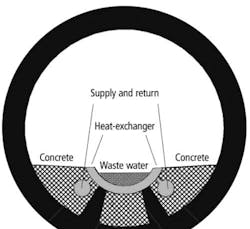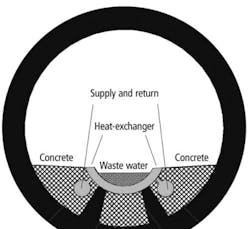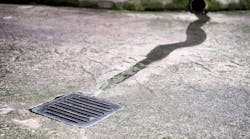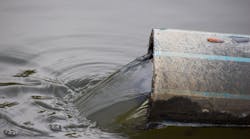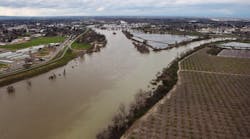By Jim Fuller and Ed Pisowicz
Stormwater is rainwater and melted snow that runs off streets, lawns, and other sites. When stormwater is absorbed into the ground, it is filtered and ultimately replenishes aquifers or flows into streams and rivers. In developed areas, however, impervious surfaces such as pavement and roofs prevent precipitation from naturally soaking into the ground. Instead, the water runs rapidly into storm drains, sewer systems, and drainage ditches and can cause:
- Downstream flooding
- Stream bank erosion
- Increased turbidity (muddiness created by stirred up sediment) from erosion
- Habitat destruction
- Changes in the stream flow hydrograph (a graph that displays the flow rate of a stream over a period of time)
- Sewer system overflows
- Infrastructure damage
- Contaminated streams, rivers, and coastal water
Why Manage Stormwater?
Traditional stormwater management design has been focused on collecting stormwater in piped networks and transporting it off site as quickly as possible, either directly to a stream or river, to a large stormwater management facility (basin), or to a combined sewer system flowing to a wastewater treatment plant.
Low impact development (LID) and wet weather green infrastructure address these concerns through a variety of techniques, including strategic site design, measures to control the sources of runoff, and thoughtful landscape planning.
LID aims to restore natural watershed functions through small-scale treatment at the source of runoff. The goal is to design a hydrologically functional site that mimics predevelopment conditions. Wet weather green infrastructure encompasses approaches and technologies to infiltrate, evapotranspire, capture, and reuse stormwater to maintain or restore natural hydrologies.
One example of systems that can provide on-site stormwater storage and infiltration are underground chambers. A variety of modular storage systems have come onto the market in the past few years. When compared to more traditional concrete chambers, the new modular systems are assembled quicker (30-50%), easier and with less machine time.
Underground storage container systems can help reduce costs and achieve the most efficient land use possible. For example, a 300 chamber SC-740 system from StormTech can be installed in less than two days and is the equivalent to 1,250 linear feet of 60” diameter pipe.
Regulations and ordinances pertaining to stormwater management continue to evolve. These changes reflect growing concerns to balance the needs of area development with environmental protection. Regulations that govern stormwater management are influenced by local area attributes and constraints, such as geology, drainage infrastructure and environmental concerns. Recognition of these local attributes and constraints in the stormwater design process helps promote conscientious development with sound environmental planning.
Companies that continue to develop products and improve upon techniques to advance environmentally sound stormwater management practices are providing safe, dependable products, whose structural design is based on national standards. Having a sound design has added more options for regulators and engineers working to address both water quantity and water quality concerns.
When detention systems are designed and modeled using the same techniques and software as surface ponds, engineers can use familiar practices for both predevelopment flow rates and volumes since they are basically the same.
There is no need to concentrate or relocate infiltration areas from the predevelopment to post development locations because development needs conflict with a surface infiltration pond. When used for infiltration, chamber systems offer the flexibility to be configured in multiple, yet cost effective arrangements, on a site to best mimic predevelopment infiltration conditions.
WW
About the Authors: Jim Fuller is VP of Sales and Marketing at Coburn Supply Co. and is a member of the WASDA Marketing Committee. Ed Pisowicz is Stormwater Product Manager for StormTech –Southeast Region, based in Atlanta, GA. He has over 20 years of experience with several manufacturers using geosynthetics and polymer based materials for drainage and stormwater applications for the civil engineering community.
More WaterWorld Current Issue Articles
More WaterWorld Archives Issue Articles
